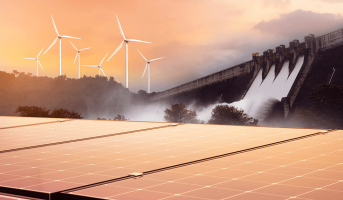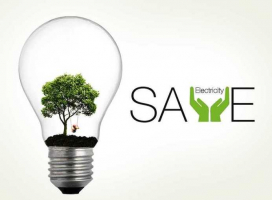Top 10 Future Energy Sources We're All Looking Forward To
The fossil fuel industry is in the midst of its zombie phase and is stubbornly refusing to perish. Powerful and viable alternative energy sources are required ... read more...by the planet. Now that we have renewable energy sources like solar cells and wind power, we actually aren't utilizing them to their best capacity. Untapped and better energy sources in the future provide a wealth of potential and could fundamentally alter the course of human history. Here are some Future Energy Sources We're All Looking Forward To.
-
Solar is still the hottest renewable energy source, although producing only 2.3% of the nation's total electricity. The truth is that if we could properly harvest all of the energy that the sun produces, we could more than meet our entire energy needs. The energy that the earth generally needs over the course of a year is produced in one hour when the sun shines on it. Although harvesting all of that may never be possible, we can undoubtedly improve upon our current methods. improved coverage using more effective energy collection techniques.
Perhaps leaving Earth behind is the answer. After all, we can only see the sun from the ground when it is daytime and the weather is suitable. If you're facing the right way once you escape the atmosphere, there is only sun. CalTech intends to deploy an array into space in 2022 or 2023 with the sole purpose of collecting solar energy. Solar cells that are small and light are now technically possible. It's not necessary to spend billions of dollars and occupy a large area of space in the sky to build an orbiting platform.
Technology is more accessible and more affordable than it ever was since the commercial world joined the space race. We might just be a few years away from developing a comparatively affordable array that can beam power down to earth via microwaves.Financial Times channel on Youtube European Space A channel on Youtube -
The majority of people immediately comprehend solar power when they hear the word, but solar fuel is another story. Although the majority of us aren't aware with the idea, it differs significantly from solar power. This is fuel rather than solar-powered electricity. Fuel that can be burned, developed using the power of the sun.
Algae power, which can be used to produce solar fuel, was mentioned earlier, but there is still more potential in this area. Hydrogen fuel can be created by splitting water atoms with the help of the sun. Additionally, it can be utilized to create ammonia and even alcohol fuels like ethanol.
Solar fuels can simply be supported by the current infrastructure for chemical fuels. The technology needs to be further developed in order for it to be worthwhile, as little work has been put into it thus far. The prospect for producing other types of solar fuel will likely grow more alluring nevertheless, now that algal power is shown its value.
CNRS channel on Youtube ETH Zürich channel on Youtube -
Tidal power is another option that has potential for utilizing the waterways in addition to offshore wind. The tides have a potential energy output of around one terawatt. One terawatt corresponds to a significant portion of the 17 terawatts that the entire world consumes annually.
Europe has seen attempts at a number of wave farms, including ones in Portugal, France, and other countries. Although they have demonstrated the concept, they have not yet demonstrated long-term viability. Past initiatives have been ruined by difficulties maintaining functional turbines. By no means a lot, but it demonstrates that there is promise. Local power networks in coastal areas may be able to benefit from the technology if it can be scaled up effectively.
DW Planet A channel on Youtube Student Energy channel on Youtube -
In the US, geothermal energy accounts for just 0.4% of total energy. Literally speaking, it is at the bottom of the renewable energy food chain. Its lack of significance is primarily the result of engineering issues. Historically, it has not been worthwhile to make geothermal technology viable, similar to fusion. It is not worthwhile if it requires more time, effort, or money to obtain the same amount of power. Fortunately, technology keeps developing, and geothermal is about to become much more economically viable.
Geothermal energy is designed to draw heat and electricity from the planet. There is a lot of potential in the Earth's core, which generates roughly as much heat as the sun. Of course, tapping that does provide logistical challenges because it is 4,000 miles underground. Since the heat is produced by radioactive decay, it should continue to do so for a few billion years. According to calculations of practical power, the world's energy requirements could be met for nearly 2 million years by 0.1% of the heat in the Earth.
Geothermal energy is undoubtedly the most consistent and dependable renewable resource. Weather patterns have an impact on the wind and sun. The energy is continually present, and the Earth's core is constantly hot. The technology is already being developed, and the engineering is being mastered in order to make it practical.
alternativeenergy1 channel on Youtube DW Planet A channel on Youtube -
Since 1951, when the EBR-1 became the first operational power plant producing electricity, nuclear power has existed. It has been around for at least 70 years with some dispute. It generates a lot of power, but when something goes wrong, it really goes wrong. Ask anyone who used to live close to Chernobyl or Fukushima. Nuclear power does experience periodic disasters, but even when everything goes according to plan, there are issues. the waste kind. Nuclear waste from nuclear fission is extremely harmful.
The majority of waste that cannot be utilized in some way is placed in sealed containers and shipped to storage facilities, where it will remain for all but an eternity. Salt rock, clay, or granite mountains or mines that have been hollowed down are frequently used as cemeteries for storing trash. These items are built to keep trash for a million years, literally. Much waste continues to be radioactive for 1,000–10,000 years. And while hazardous waste can be produced by every business, nuclear waste still has some potential. It is still creating energy since it is radioactive. That is manageable.
Nuclear recycling aims to simply employ the waste from one reactor in another. Unusually inefficient at generating power are nuclear reactors. In fact, nuclear waste has the capacity to supply a century's worth of electricity to the whole US power grid. Additionally, when garbage is continually recycled to produce power, the radiation content of the final waste that cannot be recycled increases. Instead of thousands of years, it will decompose into a harmless condition in just a few hundred.Orano channel on Youtube Argonne National Laboratory channel on Youtube -
The best thing about wind is that it practically always exists outside. It is simpler to harness the power the more open space you have. And one of the finest areas to locate wind that won't be obstructed by structures or trees is out on the ocean. Using offshore wind farms is a fantastic way to benefit from renewable energy.
The potential output of offshore wind is 120,000 gigawatts. That equates to 11 times the anticipated 2040 worldwide demand for electricity. About three times as much power is produced by offshore turbines than by on-shore ones. Additionally, since people don't have to look at them, they are less likely to irritate others.
What wind farms would do to the fishing sector is currently the biggest disadvantage. The industry is concerned that construction would drive fish away and make it more difficult to fish and navigate because of the turbines. The potential advantages are obvious if those logistics can be worked out.
DW Planet A channel on Youtube Financial Times channel on Youtube -
Wind energy used to seem incredibly self-explanatory. Since Don Quixote initially had issues with them, windmills have existed, and they are still in use today for the generating of electricity all over the world. But only 8.4% of the country's electricity is currently generated by wind. Due to this, it really surpasses other sources of renewable energy in America, such as solar. However, it can perform better. In actuality, much better.
A resource that is constantly available is wind. With the constant presence of wind, not even the sun can compete. Windmills that are based on the ground are the issue. You are aware that the wind does not always blow directly downward. But what happens if you ascend high enough? Flying wind turbines can be used when the wind is stronger and more reliable.
Like kites, flying wind turbines are constructed. They may be configured to two heights of roughly 1600 feet, where the wind is significantly stronger. Some flying turbines can produce two times as much electricity as turbines perched on towers. One of these enormous, blimp-style turbines was installed in a remote Alaskan community by a firm by the name of Altaeros to assist in supplying electricity to remote villages that frequently have erratic power coverage. Helium is used to fill the self-sustaining turbine, which is attached to the ground.TED-Ed channel on Youtube Lesics channel on Youtube -
Who would have suspected that The Matrix's machines were onto something? A person can genuinely serve as a source of energy. And fortunately for us, nobody needs to be kept in a virtual reality environment. Humans waste energy constantly, much of which can be harvested and used again if we so choose. We could be making better use of the heat and kinetic energy that we continuously waste.
In 2008, scientists created a knee brace that can use kinetic energy to power portable electronics. Basically, you could walk around while charging your phone. Traditional battery technology may be used in wearable and implantable technologies. But in the future, things would be much simpler and less expensive to maintain if such devices could be powered by motion energy, body heat, or the electrical charge generated by a human body.
TEDx Talk channel on Youtube Seeker channel on Youtube -
Algae is a strange yet very intriguing fuel source that exists in the globe. Pond and fish tank green scum has incredible potential for producing biodiesel and other things. While photovoltaic cells may generate electricity from the sun's light, bio-photovoltaic cells generate electricity in a manner similar to that of plants. To turn sunlight into electricity, cells engage in photosynthesis. Algae is a simple way to develop the plant cells that are required, which are all that are required for it to happen.
When exposed to sunlight, algae undergo photosynthesis, which produces and loses electrons. When these electrons develop on the bio-photovoltaic cells, they may immediately be utilized as useful electricity. It resembles an ideal, little battery. Although they don't have the same energy efficiency as solar, they could be highly helpful in remote places and developing nations where there are no modern power infrastructures.
The first state in the US to establish an algal biofuel factory that turned out to be a carbon-negative project was Alabama. Algae are used in the plant to remediate local wastewater. Because the algae ate all the waste that would typically need to be cleaned out, the wastewater that would otherwise be wasted is actually clean water that can be released back into the environment.The process can then be continued by turning the algae itself into biofuel. So, unlike other energy sources, this produces a dependable, clean fuel while also aiding in environmental cleanup, giving it a one-two eco-friendly job punch.
Cambridge University channel on Youtube Seeker channel on Youtube -
Fusion energy has been long anticipated by the world. Since it keeps the sun functioning, we might assume it is generally dependable. Harnessing it for useful purposes is a challenge. Fusion would be a significantly more effective energy source than fission, which has been successful but is also incredibly inefficient and potentially deadly. More energy is generated, and less trash is created as a result.
Fusion has been a subject of discussion for a while. The 1940s saw the start of experiments, and they are still going strong today. And the problem isn't that we can't produce fusion reactions; rather, it's that we can't produce excellent ones. Starting a fusion reaction requires a lot of energy, more than we have been able to produce so far.
Fusion power's sustainability and dependability have received a wide range of predictions. However, many believe the genuine thing might arrive in the 2030s or 2040s. A straightforward and widely available hydrogen isotope serves as the fuel for fusion processes. Helium is produced through fusion, not nuclear fission and its radioactive waste. As a result, we would have infinite power and celebration balloons.
Technology allows for magnetic confinement of the plasma; all that has to be done is to iron out the kinks in reaction engineering. A power source that is four million times more efficient than fossil fuels is the end result.CBC News channel on Youtube Dr Ben Miles channel on Youtube































